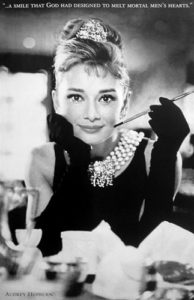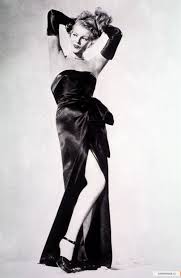List: The Best Glove Movies
Posted on November 30, 2009 at 3:59 pm

At Thanksgiving, my mother brought out a collection of about 30 pairs of gloves, most of them her mother’s but a few my sisters and I had when we were little girls back in the days when young ladies wore white gloves to go into the big city, attend religious services, or fly in an airplane. I took home two pairs of wrist-length white kid gloves and our daughter picked out two elegant pairs of opera-length gloves. It made me think of some of my favorite gloves in classic movies. Like cigarettes, gloves give rise to a ballet of expressive movements that can be very evocative and even help to tell the story and reveal the character. These are not wool or leather gloves worn for warmth or protection; these are indoor gloves, worn for elegance. Well, except for the last two.
1. Let’s Make Love You can glimpse Marilyn Monroe wear two pairs of gloves in this trailer for her movie about a wealthy man who tries to shut down a satiric musical show because it makes fun of him. The pair I love is the short daytime gloves she wears in the elevator, while Yves Montand is kissing her and singing.
2. The Age of Innocence Director Martin Scorsese shows us that sex and violence can be powerfully portrayed even without guns and goodfellas. In this story of impossible love based on the novel by Edith Wharton and set in 19th century New York high society, Daniel Day-Lewis kisses Michelle Pfeiffer on the wrist under an unbuttoned glove and it is as erotically charged an image as has ever been filmed.
3. Little Women Older sister Meg loans a glove to her impetuous sister Jo so that they can both be properly attired at a party in this film of the classic novel by Louisa May Alcott. Jo has spoiled one of hers and it would be unthinkable for well-brought-up young ladies to go out without them, so each wears one and carries one.
4. Woman of the Year Spencer Tracy and Katharine Hepburn began one of the great on and off-screen love stories in this film about the romance between a sports writer and a columnist. The gloves (and hat) she wears to her first baseball game are hilarious.
5. Lover Come Back In this frothy Doris Day/Rock Hudson comedy, Day wears 1960’s professional woman chic, beautiful suits and impeccable white gloves.
6. Meet Me In St. Louis Only Vincente Minnelli would think of putting his heroine (Judy Garland) in purple gloves for her clang-clang-clang “Trolley Song” number in this turn-of-the-century musical based on the childhood memories of Sally Benson at the time of the St. Louis World’s Fair.

7. Gilda Rita Hayworth wears long black gloves in one of the steamiest dance numbers in history, “Put the Blame on Mame.”
8. Breakfast At Tiffany’s Watch this movie and you’ll want to wear gloves like Audrey Hepburn, the essence of elegance in this Truman Capote story about two people who have made many compromises but find the courage to build a relationship that will make them be honest with each other and themselves.
9. This Is Spinal Tap This outrageously funny mockumentary about a metal hair band includes a hilarious scene where they get the news that the record company will not permit the art they selected for their new album, “Smell the Glove.” For some reason, they found it offensive.
10. Yellow Submarine Who can forget the Dreadful Flying Glove, one of the most important weapons of the Blue Meanies but no match for the music and love of the Beatles in this animated classic?
And in one of my favorite opening credit sequences, the lovely ladies of “Deliver Us From Evil” dance to “You’re All I Need to Get By” in elegant attire, including, of course, gloves.

